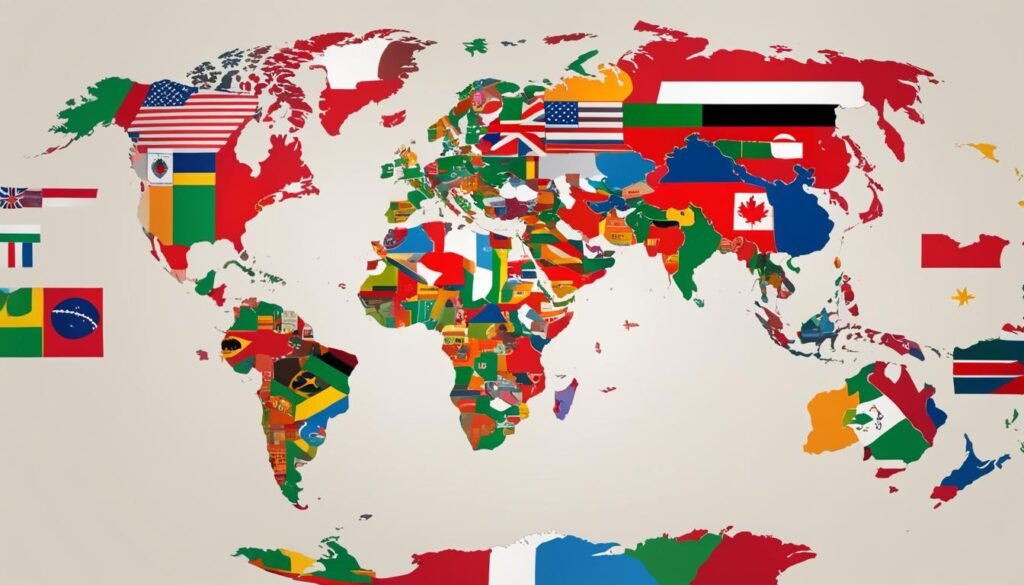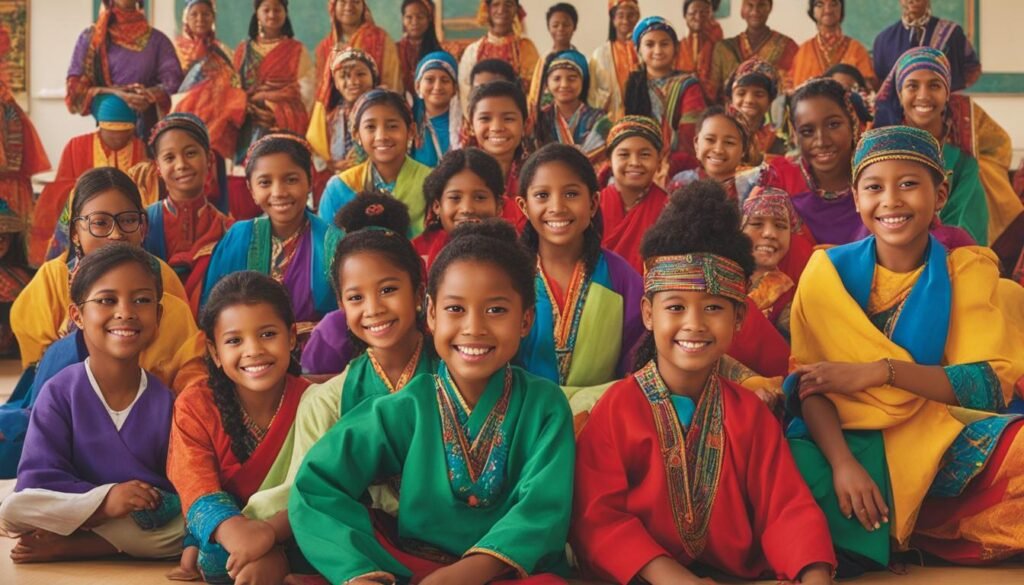Cultural diversity is a fascinating aspect of our global society. It encompasses the rich tapestry of global cultures, highlighting societal differences that shape our identities and communities. Exploring cultural diversity opens doors to understanding and appreciation, fostering inclusive environments where different cultural groups can thrive and coexist harmoniously. In this comprehensive exploration, we delve into the significance of cultural diversity, its impact on society, and the need for cultural awareness in community building.
Key Takeaways:
- Cultural diversity encompasses various aspects of human experience, such as knowledge, beliefs, customs, languages, and more.
- Understanding cultural diversity is vital for building inclusive communities and fostering strong alliances among different cultural groups.
- Embracing cultural diversity brings diverse perspectives, resolving common issues, and promoting social justice.
- Cultural diversity in education requires acknowledging and respecting the unique backgrounds and experiences of students.
- Teachers play a crucial role in promoting cultural diversity by creating inclusive classrooms and practicing cultural sensitivity.
Defining Culture: A Multifaceted Perspective
Culture is a multifaceted concept that encompasses a wide range of elements, including diverse knowledge, beliefs, customs, and languages. It refers to the shared experiences and values that shape the understanding of the world within a particular group or community.
One of the fundamental aspects of culture is the transmission of knowledge from one generation to another, which includes not only factual information but also the beliefs and values that shape individuals’ identities. These shared beliefs and values create a sense of belonging and identity within a cultural group, providing individuals with a framework for understanding themselves and the world around them.
Furthermore, culture is not a static entity but a dynamic and evolving phenomenon. It changes over time and is influenced by various factors, such as history, geography, social interactions, and technological advancements. As a result, people can belong to multiple cultures simultaneously, each contributing to their unique identity and perspective.
The Impact of Culture on Identity and Society
Culture plays a significant role in shaping individual and collective identities. It influences how people perceive themselves and others, their values, behaviors, and social interactions. Cultural differences can lead to diverse perspectives and worldviews, which in turn can contribute to social and intellectual progress.
Moreover, culture is not only a personal matter but also has a broader societal impact. It influences social norms, customs, and traditions, providing a framework for how societies function. Understanding and appreciating cultural diversity is crucial for building inclusive communities that respect and value the contributions of all individuals, regardless of their cultural background.
By recognizing the multifaceted nature of culture and its impact on identity and society, we can foster a more inclusive and harmonious world where diverse knowledge, beliefs, customs, and languages are celebrated and appreciated.
The Importance of Cultural Diversity in Community Building

Cultural diversity plays a crucial role in community building by bringing together diverse perspectives and creating stronger coalitions. When individuals from different cultural backgrounds come together, they bring with them a wealth of experiences, knowledge, and ideas that can benefit the entire community. By embracing cultural diversity, communities can tap into the unique strengths and wisdom of various cultural groups, leading to a more inclusive and equitable society.
One of the key benefits of cultural diversity in community building is the opportunity to gain diverse perspectives. When people from different cultures come together, they bring with them unique viewpoints shaped by their cultural backgrounds. This diversity of perspectives allows communities to approach challenges and problem-solving from various angles, leading to more innovative and effective solutions. Cultural diversity also promotes greater understanding and empathy among community members, fostering a sense of unity and cooperation.
The Benefits of Cultural Diversity in Community Building
- Enhanced problem-solving and innovation through diverse perspectives
- Greater understanding and empathy among community members
- Improved communication and collaboration skills
- Increased cultural awareness and appreciation
- Promotion of social justice and equality
In addition to fostering diverse perspectives, cultural diversity in community building also creates stronger coalitions. When individuals from different cultural backgrounds come together to address common issues, they can form alliances that are more powerful and impactful. These coalitions have the potential to bring about positive change by drawing on the collective strengths and resources of diverse cultural groups. By embracing cultural diversity, communities can build stronger, more resilient networks that can effectively address societal challenges.
Embracing cultural diversity in community building is essential for creating a more inclusive and equitable society. By valuing and appreciating the contributions of different cultural groups, communities can tap into the power of diverse perspectives and forge strong alliances. By fostering an environment that promotes understanding, empathy, and collaboration, cultural diversity can help build a stronger and more harmonious community for all.
Types of Cultural Diversity in Education

In the field of education, cultural diversity encompasses various aspects that enrich the learning experience for students. It includes factors such as race, ethnicity, religion, language, socioeconomic status, sexual orientation, and gender identity. Recognizing and embracing this diversity is crucial for creating inclusive and equitable educational environments.
Race and Ethnicity:
One important aspect of cultural diversity in education is race and ethnicity. Students from different racial and ethnic backgrounds bring unique perspectives and experiences to the classroom. By understanding and appreciating these differences, educators can create an environment that celebrates diversity and promotes cross-cultural understanding.
Religion:
Religious diversity is also an important component of cultural diversity in education. Students from various religious backgrounds may have different beliefs and practices. It is essential for educators to foster an inclusive environment where students feel respected and supported in expressing their religious identities.
Language:
Language diversity is another significant aspect of cultural diversity in education. Students who speak different languages as their first language or come from bilingual backgrounds contribute to the richness of the classroom. Supporting language diversity includes implementing appropriate language support programs and encouraging students to maintain their language skills while learning a new language.
Socioeconomic Status:
Socioeconomic diversity plays a crucial role in cultural diversity in education. Students from different socioeconomic backgrounds face unique challenges and bring diverse perspectives to the classroom. Recognizing and addressing these differences can help create a more inclusive learning environment that supports all students’ academic and emotional needs.
Sexual Orientation and Gender Identity:
Finally, cultural diversity in education includes sexual orientation and gender identity. It is important for educators to create an inclusive space where students of all sexual orientations and gender identities feel safe, respected, and supported. This includes using inclusive language, incorporating LGBTQ+ perspectives into the curriculum, and providing resources and support for LGBTQ+ students.
Incorporating cultural diversity in education benefits all students by promoting understanding, empathy, and critical thinking skills. It prepares them to navigate a diverse and interconnected world, fostering respect and appreciation for different cultures and identities.
Promoting Diversity and Multiculturalism in the Classroom
As educators, it is our responsibility to promote diversity and multiculturalism in the classroom. By embracing the richness of cultural differences, we create a learning environment that celebrates and values every student’s unique background. Culturally responsive instruction is a powerful tool that helps foster an inclusive classroom where all students feel seen, heard, and respected.
Strategies for Promoting Diversity and Multiculturalism
- Get to know your students: Take the time to learn about your students’ cultural backgrounds, traditions, and experiences. This knowledge will help you create connections and build relationships with each student.
- Maintain consistent communication: Open lines of communication with students and their families. Encourage open dialogue about cultural differences and promote an environment where everyone feels comfortable sharing their perspectives.
- Acknowledge and respect cultural diversity: Incorporate diverse perspectives into your lessons and classroom materials. Use culturally relevant examples and resources that reflect the experiences of all students.
- Practice cultural sensitivity: Be mindful of cultural norms and values when interacting with students. Avoid making assumptions or generalizations based on stereotypes. Instead, approach each student with respect and an open mind.
The Power of Inclusion
By promoting diversity and multiculturalism in the classroom, we empower students to embrace their own identities and learn from one another. When students see their cultures and backgrounds represented and valued, they develop a deeper sense of belonging and self-worth. This inclusive environment fosters empathy, understanding, and collaboration, preparing students for success in an increasingly diverse world.
Remember, promoting diversity and multiculturalism is an ongoing process. It requires continuous learning, reflection, and adaptation. By prioritizing cultural responsiveness in our teaching practices, we can create classrooms that celebrate the richness of our diverse society and nurture the growth of every student.
The Benefits of Multicultural Education for Students
Multicultural education offers numerous benefits for students, enhancing their cultural awareness and preparing them for a diverse world. By exposing students to diverse cultural experiences and perspectives, multicultural education fosters a sense of empathy, respect, and acceptance for different cultures. This understanding contributes to the creation of inclusive and harmonious classroom environments where students from various backgrounds feel valued and supported.
One of the key advantages of multicultural education is that it promotes student success. By incorporating diverse perspectives into the curriculum, educators provide students with a well-rounded education that prepares them for the global workforce. Students who have been exposed to different cultures are better equipped to navigate diverse social contexts, communicate effectively across cultural boundaries, and collaborate with individuals from various backgrounds.
Moreover, multicultural education plays a vital role in building cultural awareness among students. By learning about different cultures, traditions, and histories, students develop a broader understanding of the world and the people who inhabit it. This cultural awareness not only enhances their knowledge and appreciation of diversity, but also helps break down stereotypes and biases, fostering an environment of mutual respect and understanding.
The benefits of multicultural education can be summarized as follows:
- Enhanced cultural awareness and appreciation
- Preparation for a diverse and globalized world
- Improved academic performance and student success
- Development of empathy and respect for different cultures
- Breaking down stereotypes and biases
The Role of Educators in Promoting Cultural Diversity
Educators have a crucial role to play in promoting cultural diversity and creating inclusive classrooms. By embracing this responsibility, they contribute to the development of a society that values and respects diverse cultures and perspectives.
The Responsibilities of Educators
- Creating an inclusive learning environment: Educators should foster a safe and welcoming space where students from different cultural backgrounds feel valued and included. This can be achieved through diverse classroom materials, culturally relevant teaching resources, and a curriculum that reflects the experiences of all students.
- Cultivating cultural competence: Educators must be culturally competent, which involves understanding and appreciating the diversity of their students. They should seek to learn about different cultural practices, beliefs, and values, and integrate this knowledge into their teaching strategies.
- Promoting cultural awareness: Educators can promote cultural awareness by organizing activities, discussions, and projects that allow students to explore and appreciate different cultures. This helps students develop empathy, respect, and a broader understanding of the world.
- Addressing biases and stereotypes: Educators should actively challenge biases, stereotypes, and discriminatory behaviors in the classroom. By promoting a culture of respect and acceptance, they can help students overcome prejudice and build positive relationships with individuals from diverse backgrounds.
Strategies for Promoting Cultural Diversity
- Incorporating multicultural content: Educators should integrate diverse perspectives, histories, and cultures into their lesson plans. This can be done through literature, artwork, music, and guest speakers that represent a wide range of cultural backgrounds.
- Encouraging dialogue and collaboration: Facilitating open discussions about cultural diversity encourages students to share their experiences and perspectives. Collaborative projects that require students to work together and learn from one another foster a sense of community and promote cultural understanding.
- Providing professional development: School administrators should provide ongoing professional development opportunities for educators to enhance their cultural competence. Training sessions, workshops, and conferences can equip educators with the knowledge and skills necessary to effectively support and promote cultural diversity.
- Engaging families and communities: Educators should actively involve families and community members in the educational process. By collaborating with parents and caregivers, educators can ensure that cultural diversity is celebrated and recognized both within and outside the classroom.
By embracing their role in promoting cultural diversity, educators contribute to the creation of inclusive societies that celebrate and appreciate the richness of different cultures. Through their efforts, they empower students to become global citizens who are capable of navigating and positively contributing to an increasingly diverse world.
Conclusion
Cultural diversity plays a vital role in creating diverse communities and inclusive societies. By embracing the richness of different cultures and fostering understanding among individuals from various backgrounds, we can build a more harmonious and equitable world.
Recognizing the value of cultural diversity is the first step towards building inclusive societies. By appreciating and celebrating the unique knowledge, beliefs, and customs of different cultural groups, we can create a sense of belonging and unity.
Building understanding is key in promoting cultural diversity. Through education and awareness, we can challenge stereotypes, address biases, and cultivate empathy for others. By actively engaging with diverse perspectives, we can break down barriers and create spaces that honor and respect the contributions of all individuals.
In conclusion, cultural diversity is a powerful force that enriches our lives and contributes to the growth and progress of societies worldwide. By embracing diverse communities and fostering inclusive societies, we can create a future where everyone’s unique heritage and experiences are valued, celebrated, and respected.
FAQ
What does cultural diversity refer to?
Cultural diversity refers to the coexistence of diverse knowledge, beliefs, arts, morals, laws, customs, religions, languages, abilities and disabilities, genders, ethnicities, races, nationalities, and sexual orientations of human beings.
Why is understanding cultural diversity important?
Understanding cultural diversity is important as it fosters inclusive communities, builds strong alliances among different cultural groups, and promotes social justice.
What is the impact of cultural diversity on identity and society?
Cultural diversity shapes individual and collective identities and has a significant impact on society by bringing together diverse perspectives, resolving common issues, and fostering mutual understanding.
What is the significance of cultural diversity in community development?
Cultural diversity plays a vital role in community development by tapping into the unique strengths, ideas, and wisdom of different cultural groups, leading to a more equitable and inclusive society.
What types of diversity are encountered in educational settings?
Cultural diversity in education encompasses aspects such as race, ethnicity, religion, language, socioeconomic status, sexual orientation, and gender identity.
How can teachers promote diversity and multiculturalism in the classroom?
Teachers can promote diversity and multiculturalism by getting to know their students, maintaining consistent communication, acknowledging and respecting each student’s culture, practicing cultural sensitivity, and incorporating diversity into lesson plans.
What are the benefits of multicultural education for students?
Multicultural education enhances cultural awareness, fosters a sense of identity, prepares students for a diverse world, improves academic performance, social skills, and overall student success.
What is the role of educators in promoting cultural diversity?
Educators play a vital role in promoting cultural diversity by possessing cultural competence, addressing biases, incorporating culturally responsive teaching practices, and creating a safe and inclusive learning environment.
Source Links
- https://link.springer.com/10.1007/978-3-319-69902-8_37-1
- https://ctb.ku.edu/en/table-of-contents/culture/cultural-competence/culture-and-diversity/main
- https://drexel.edu/soe/resources/student-teaching/advice/importance-of-cultural-diversity-in-classroom/


